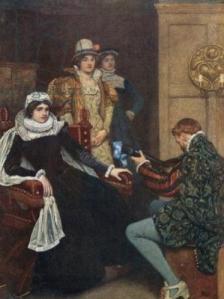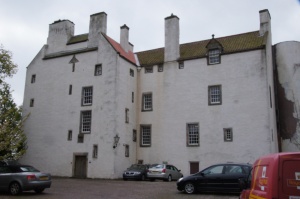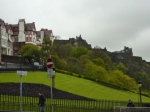Pity the poor writers and producers of CW’s “Reign.” It has not yet hit TV screens in the US, yet the network is already defending the dramatic license they have taken with the series. (“Reign’ boss defends show’s relaxed approach to historical accuracy“). The CW team, defending the series, keeps saying that they are “not the History Channel.”No really? They need to come up with a response that has a bit more credibility. “We’re not the History Channel, so we can make up whatever we like” is not a real defense. “We’re meeting a market need for a teenage, historical fiction drama and we chose to create a series about Mary Queen of Scots because a) b) c) …” might get them less flak and enable them to take their tin hats off.
I’ve already posted a couple of times my surprise that the CW would take huge license with the story of Mary, Queen of Scots. Her life is replete with all the drama and scandal a series could wish for when told with detailed accuracy. From the day she escaped from the approaching English army and hid at Inchmahome Priory on Lake Menteith, Mary’s life was a rollercoaster of dazzling highs (crowned Queen of France) and humiliating lows (abdicating her throne; eventually being beheaded by her cousin Elizabeth I). Who needs to make s*** up? I could have given the CW years of great storylines on Mary and her posse (I’m still available for the asking, btw). Skillfully handled, her story is amazing and heartbreaking.
I love the true life story of Mary Stuart. I still have a copy of from the early 1970s of Lady Antonia Fraser‘s wonderful non-fiction biography of her, which I read when I was just eleven years old (and very precocious with it!) and captivated me. I hate that her life is being brought to the small screen with less than great attention to detail and the real drama that was her life. It is my hope that the creators of Reign have color just a little outside the historical lines, and not disregarded them completely.
But I get it, I watch the CW from time to time. OK. Week to week. I confess I have a wee addiction to the CW’s ‘Vampire Diaries‘ and have always thought that Ian Somerhalder would make the perfect Pierre de Bocosel de Chastelard (here’s my blog post on that sensational story). I know, I’m probably the oldest CW viewer (it’s sad really). There is absolutely nothing real about the Vampire Diaries, nothing at all and yet I love it. Similarly, I watched Starz’s ‘DaVinci’s Demons‘ which, I’m guessing, bears not much more than a passing nod to reality, but I enjoyed it anyway. Ditto both The Tudors and The Borgias TV series. In the CW’s defense, its target market is probably the 18-24 year-old crowd who want fast-paced, slightly steamy entertainment (I’m guessing here, but I was in that age bracket once) and that target audience are not too worried about what is true and what is not. The CW is great at marketing to its target audience, and I have to believe they know what it wants.
So if writers and producers make free with historical fact, but create really entertaining drama, should we complain? Is the CW getting an undeserved kicking before the show even airs? Perhaps. For me, I have to see how far they’ve taken their creative license. I mean, if teenage Mary Stuart starts having it away with, say Nostradamus (who I understand is cast as a young big of al’right played by Rossif Sutherland) I might complain. But if they are making more of the relationship between Mary and the Dauphin Francis, her betrothed, then I could be OK with it.
One way or another I’ll be watching the series end-to-end when it premiers in October. For one thing, I can’t imagine Megan Fellows as Henry II’s wife, Catherine de Medici. It will take some great acting to make me see her as anyone other than Anne of Green Gables! (Megan, I’m rooting for you.)
Here’s a link to a preview. (Someone tell me why Mary, Queen of Scots, has an English accent? — People! The actress is Australian, surely they could’ve coached her?)
Related articles
- The Lumineers Make History Hot For The CW’s ‘Reign’ (huffingtonpost.com)
- ‘Vampire Diaries’, ‘Supernatural’ premiere dates changed by The CW (digitalspy.co.uk)
- Upcoming Period Dramas: Mary, Queen of Scots (ladyandtherose.wordpress.com)
- The Cw Network Announces Fall 2013 Premiere Dates (cwpittsburgh.cbslocal.com)




























